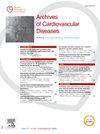心肌缺血和血运重建筛查对心血管预后的影响:来自Nancy缺血登记的见解
IF 2.3
3区 医学
Q2 CARDIAC & CARDIOVASCULAR SYSTEMS
引用次数: 0
摘要
背景心肌缺血的检测和管理,特别是在高危人群中,是减少主要心血管不良事件(MACE)的关键策略。筛查和血运重建在初级预防中的益处尚不清楚。南希缺血登记旨在研究心肌缺血筛查和血运重建术对初级和二级预防环境下心血管结局的现实影响。方法在2021年5月至2022年12月期间,前瞻性纳入3020例患者。一级预防:CACS, CCTA。二级预防:应激回声或应激CMR。疑似心肌缺血的患者行冠状动脉造影。如果发现至少一个明显的冠状动脉病变(狭窄≥70%或血流储备分数[FFR]≤0.80),则行血运重建术。主要终点是到2023年底发生MACE,定义为心肌血运重建术或心血管死亡。结果共筛选3020例患者。一级预防队列(n = 1732): 80%无心肌缺血,9.6%(207例)行血运重建术。二级预防队列(n = 693): 78%无心肌缺血,11.6%(103例)行血运重建术。随访时:一级预防组MACE累积发生率为15%,二级预防组为20% (HR: 1.06;95% ci: [1.02-1.10];P & lt;0.01)。在中度缺血但无血运重建指征的患者中,MACE发生率为4%,而无缺血患者为2% (HR: 1.03;95% ci: [1.01-1.06];P & lt;0.05)(图1)。结论在现实世界的临床环境中,通过解剖成像筛查心肌缺血并及时实施血运重建术可显著降低高危患者主要不良心血管事件的发生率。这种益处在初级预防队列中尤为明显,突出了早期发现和干预的重要性。本文章由计算机程序翻译,如有差异,请以英文原文为准。
Impact of screening for myocardial ischemia and revascularization on cardiovascular outcomes: Insights from the Nancy ischemia registry
Background
Early detection and management of myocardial ischemia, particularly in high-risk individuals, represent a critical strategy for reducing major adverse cardiovascular events (MACE). The benefit of screening and revascularization in primary prevention remains less clear.
Objectives
Nancy Ischemia Registry aims to study the real-world impact of myocardial ischemia screening and revascularization on cardiovascular outcomes in both primary and secondary prevention settings.
Methods
Between May 2021 and December 2022, 3020 patients were prospectively enrolled.
Primary prevention: CACS, CCTA.
Secondary prevention: Stress Echo or Stress CMR.
Patients with suspected myocardial ischemia underwent coronary angiography. Revascularization was performed if at least one significant coronary lesion (stenosis ≥ 70% or fractional flow reserve [FFR] ≤ 0.80) was identified. The primary endpoint was the occurrence of MACE, defined as myocardial revascularization or cardiovascular death, by the end of 2023.
Results
Among the 3020 patients screened.
Primary prevention cohort (n = 1732): 80% had no myocardial ischemia, while 9.6% (207 patients) underwent revascularization.
Secondary prevention cohort (n = 693): 78% had no myocardial ischemia, while 11.6% (103 patients) underwent revascularization.
At follow-up: The cumulative incidence of MACE was 15% in the primary prevention group versus 20% in the secondary prevention group (HR: 1.06; 95% CI: [1.02–1.10]; P < 0.01).
Among patients with moderate ischemia but no indication for revascularization, MACE incidence was 4%, compared to 2% in those without ischemia (HR: 1.03; 95% CI: [1.01–1.06]; P < 0.05) (Fig. 1).
Conclusion
In a real-world clinical setting, screening for myocardial ischemia using anatomical imaging and implementing timely revascularization significantly reduced the incidence of major adverse cardiovascular events in high-risk patients. This benefit was particularly evident in the primary prevention cohort, highlighting the importance of early detection and intervention.
求助全文
通过发布文献求助,成功后即可免费获取论文全文。
去求助
来源期刊

Archives of Cardiovascular Diseases
医学-心血管系统
CiteScore
4.40
自引率
6.70%
发文量
87
审稿时长
34 days
期刊介绍:
The Journal publishes original peer-reviewed clinical and research articles, epidemiological studies, new methodological clinical approaches, review articles and editorials. Topics covered include coronary artery and valve diseases, interventional and pediatric cardiology, cardiovascular surgery, cardiomyopathy and heart failure, arrhythmias and stimulation, cardiovascular imaging, vascular medicine and hypertension, epidemiology and risk factors, and large multicenter studies. Archives of Cardiovascular Diseases also publishes abstracts of papers presented at the annual sessions of the Journées Européennes de la Société Française de Cardiologie and the guidelines edited by the French Society of Cardiology.
 求助内容:
求助内容: 应助结果提醒方式:
应助结果提醒方式:


